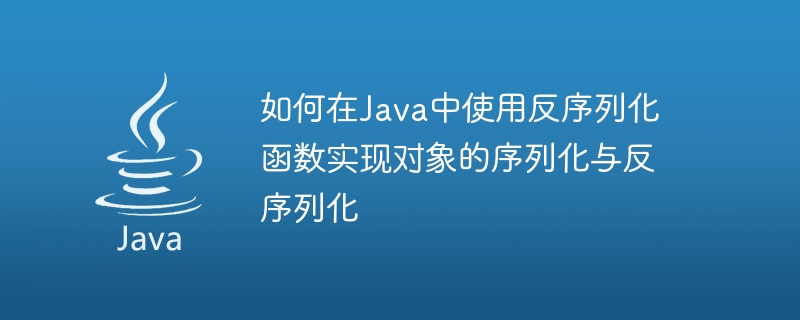
如何在Java中使用反序列化函數實現物件的序列化與反序列化
序列化是將物件轉換為可以在網路傳輸或儲存中使用的位元組流的過程,而反序列化則是將位元組流轉換回物件的過程。 Java提供了序列化和反序列化的機制,使得開發者可以方便地將物件儲存和傳輸。本文將介紹如何在Java中使用反序列化函數實現物件的序列化和反序列化,並給出具體的程式碼範例。
範例程式碼:
import java.io.Serializable;
public class Person implements Serializable {
private String name;
private int age;
public Person(String name, int age) {
this.name = name;
this.age = age;
}
// getter and setter
}範例程式碼:
import java.io.FileOutputStream;
import java.io.ObjectOutputStream;
public class SerializationDemo {
public static void main(String[] args) {
Person person = new Person("张三", 25);
try {
FileOutputStream fileOut = new FileOutputStream("person.ser");
ObjectOutputStream out = new ObjectOutputStream(fileOut);
out.writeObject(person);
out.close();
fileOut.close();
System.out.println("对象已被序列化并保存在person.ser文件中");
} catch (Exception e) {
e.printStackTrace();
}
}
}範例程式碼:
import java.io.FileInputStream;
import java.io.ObjectInputStream;
public class DeserializationDemo {
public static void main(String[] args) {
Person person = null;
try {
FileInputStream fileIn = new FileInputStream("person.ser");
ObjectInputStream in = new ObjectInputStream(fileIn);
person = (Person) in.readObject();
in.close();
fileIn.close();
} catch (Exception e) {
e.printStackTrace();
}
if (person != null) {
System.out.println("对象已经从person.ser文件中反序列化:" + person.getName() + "," + person.getAge());
}
}
}以上就是在Java中使用反序列化函數實作物件的序列化與反序列化的方法和程式碼範例。透過實作Serializable介面和使用ObjectInputStream和ObjectOutputStream類,我們可以輕鬆地將物件序列化為位元組流,或將位元組流反序列化回物件。這機制在網路傳輸和檔案儲存中都具有很大的應用價值。
以上是如何在Java中使用反序列化函數實現物件的序列化與反序列化的詳細內容。更多資訊請關注PHP中文網其他相關文章!




